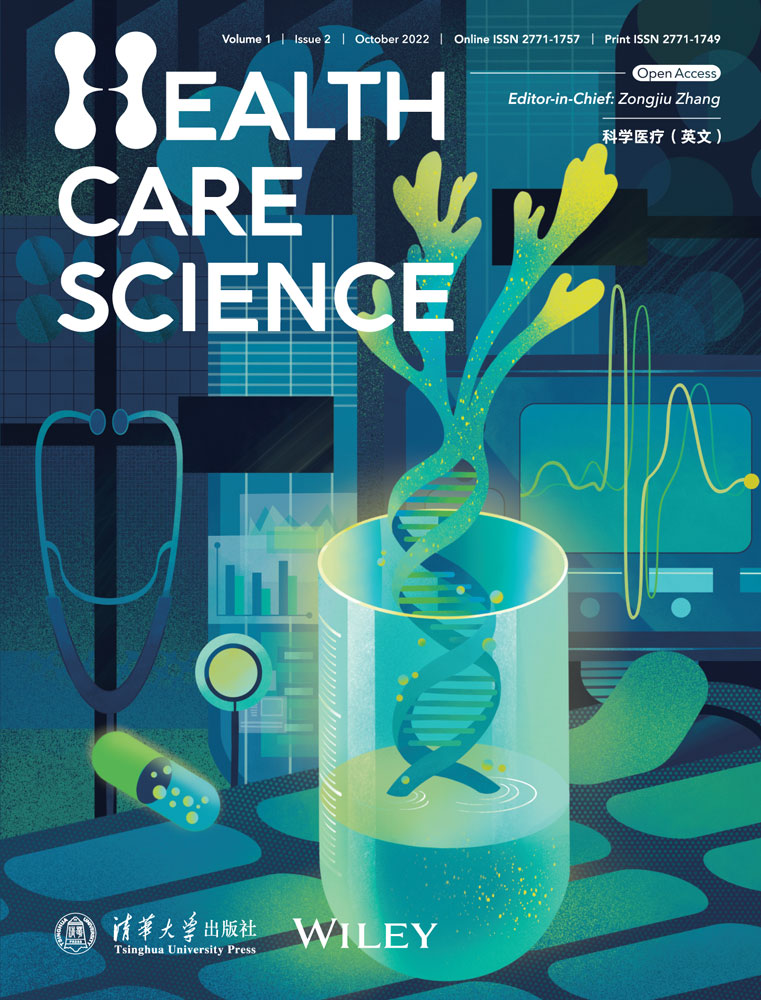Explicating the publication paradigm by bibliometric approaches: A case of interplay between nanoscience and ferroptosis
Zhengwei Huang and Wenhao Wang contributed equally to this study.
Abstract
Background
Ferroptosis has been widely investigated as an emerging drug target, while its combination with nanoscience provides bourgeoning application prospects. The development of ferroptosis regulating nanomedicines have attracted worldwide attentions in recent years. It would be meaningful to describe the relevant publication paradigm.
Methods
Herein, a bibliometric analysis was performed using the database of Web of Science Core Collection to clarify the publication paradigm. The development of related publications in the last 6 years was described, and the revolutionary trends were figured out. Ultimately, the possible future exploration directions were proposed.
Results
The bibliometric analysis of 327 documents of interest indicated that the main research focus was in multiple fields including Materials science, Science & technology, Chemistry, and Pharmacology & pharmacy. With widely cooperation and strong funding, the researchers from Chinese organizations contributed most of publications, followed with United States and Australia. Cocitation analysis revealed that several original papers reported the key molecular mechanisms of ferroptosis were considered as the foundation for subsequent studies, and some nanomedicines-related documents were taken as examples and discussed. Mining results showed that the mechanism evaluation of ferroptosis regulation therapy for cancer treatment was the hotspot. Then, several possible future explorations of ferroptosis-related nanoscience were presented and discussed.
Conclusions
The bibliometric profile of nanoscience-ferroptosis research was analyzed in detail. We believe that the bibliometric analysis could act as a robust method for explicating the publication paradigm as a certain field.
Abbreviations
-
- CoQ10
-
- coenzyme Q10
-
- Cys
-
- cysteine
-
- Fe2+
-
- iron (II) ions
-
- Glu
-
- glutamate
-
- GPX4
-
- glutathione peroxidase 4
-
- GSH
-
- glutathione
-
- L-OOH
-
- lipid peroxidate
-
- LOX
-
- lipoxgenase
-
- PUFA
-
- polyunsaturated fatty acids
-
- ROS
-
- reactive oxygen species
-
- system Xc−
-
- cystine-glutamate antiporter
-
- WoS
-
- Web of Science
1 INTRODUCTION
How to explicate the publication paradigm of a certain topic? This is a vital issue to be answered by the science community, including the healthcare science community. Our work was designed to provide a feasible approach to fulfill such an aim. To make a vivid showcase, the publication paradigm of an emerging front, the interplay between nanoscience and ferroptosis, was analyzed as a proof of concept. The detailed background of this field is shown below.
Since the invention of high-resolution scanning tunneling microscope [1], “nanometer” and its relevant concepts have attracted tremendous attention in the science community. Under this circumstance, the field of nanoscience was opened up. Nanoscience is mainly concerned about the physical, chemical, and biological attributes and functions of the matter with nanometered size (generally 100–102 nm) [2]. Boosting development of nanoscience is witnessed over decades, and it has been widely applied in the field of physics, chemistry, mechanics, microelectronics, and medicine [3].
In particular, nanomedicine, the intersection of nanoscience and medicine, is shed light on. The concept of nanomedicine was put forward by National Institutes of Health, and the studies on nanomedicine has been burgeoned all around the world. According to the definition, nanomedicine includes nanoscale pharmaceuticals (like liposomes and micelles [4]) and the nanotechnologies for medical purposes (like DNA sequencing and pathogen detection [5]). It is perceived that the enhanced permeability and retention effect can facilitate the targeting of nanoscale pharmaceuticals and improve the therapeutic efficacy [6], and the nanotechnologies are efficient tools for diagnose, laboratory, and clinical investigations [7]. Nanomedicine will provide new strategy for disease prevention and therapy, and elevate the health level of human beings.
Of note, the identification of various drug targets always motivates the development of nanoscience, especially the aspect of nanomedicine, as these drug targets impose the demand to exploit the druggability and molecular mechanisms [8]. For example, molecules with apoptosis-inducing activity are incorporated into a diversity of nanosystems [9-11]; nanosystems are employed to investigate the mechanisms of autophagy [12], pyroptosis [13], and NETosis [14]. Interestingly, there is an interaction between nanoscience and drug targets. For one thing, the agonists and antagonists can be accommodated into nanosystems as a remedy. For another thing, nanotechnology can help to probe the underlying mechanisms.
Ferroptosis, a programmed cell death pathway defined in 2012 [15], acts as a new drug target. Briefly, it is an iron-induced lipid peroxidation process, associated with the downregulation of cystine-glutamate antiporter, glutathione peroxidase 4 (GPX4) and polyunsaturated fatty acids (PUFAs), and the upregulation of reactive oxygen species (ROS) [16, 17]. The main mechanisms of ferroptosis are illustrated in Scheme 1. Morphologically, swollen cell structure, condensed mitochondrial membrane, and disappeared mitochondria crista are typical manifestations of ferroptosis [18, 19]. It is worth mentioning that ferroptosis is a nonapoptotic process which can bypass the resistance of most current anticancer drugs, and may create new possibility for cancer therapy [20]. Therefore, great research interests are being host toward ferroptosis now.
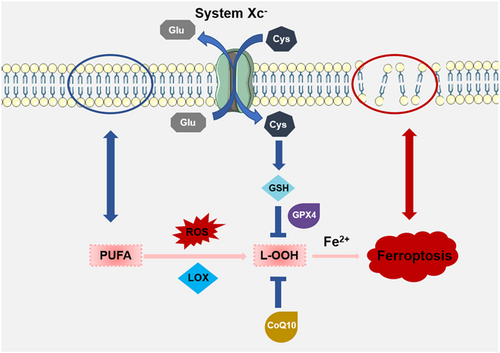
Under such conditions, a new science frontier, nanoscience-ferroptosis, is burgeoning. It is predicted that the main publication paradigm of related studies is in two manners: Ferroptosis agonists/antagonists loaded nanosystems and nanotechnology for the exploration of ferroptotic mechanisms. To scrutinize the publication paradigm to master the current and future research hotspots, bibliometric analysis need be performed [21].
In this study, the publication paradigm representing the interplay between nanoscience and ferroptosis was explicated, through general bibliometric profile, coauthorship visualization, cocitation and bibliographic coupling analysis, and mining and mapping of high-frequency terms. Noticeably, the literature survey was conducted within Core Collection of Web of Science (WoS), so as to obtain documents with relatively high quality and impact [22]. Inspired by the bibliometric results, some topics pending future studies were summarized. Given the established method could be extrapolated into other fields, we anticipated that this study would help to understand the research paradigm of nanoscience-ferroptosis studies, and offer valuable reference for investigators in clarifying publication paradigm of a certain topic.
2 RESULTS AND DISCUSSION
The papers regarding the interplay between nanoscience and ferroptosis were assessed from a bibliometric perspective, and the relevant results and discussion were showcased as follows. Of note, the following results and discussion not only reflected the outcome of current bibliometric study, but also indicated a general analytical style for publication paradigm explication.
2.1 General bibliometric profile
With the purpose of explicating the publication paradigm, one should first master the general bibliometric profile of involved documents. Literature survey was performed in the Core Collection of WoS, and the results were exported and illustrated below.
A total number of 327 papers of interest was obtained. Among them, 129 were published in open access journal, and 198 in subscription journal. There were 265 articles and 62 reviews. The sum of times cited was 6485, and the averaged value per document was 19.83, with an H-index of 44. In comparison of previous studies [23, 24], the H-index was relatively high, suggesting that these papers could arouse impact in their field and attract citations.
In terms of the distribution of publication years (Figure 1), the first three papers were published in 2016, and another three papers in 2017. It was indicated that the cooperation of nanoscience and ferroptosis was a relatively new topic. From 2018, the number of publications burst, and the value reached 169 in 2021. Considering the portrait of the scatter diagram, a parabola model was used for nonlinear fitting. A significant fitted formula y = 3.83 × 107 − 3.80 × 104x + 9.43x2 (R2 = 0.9980, p = 0.000069) was obtained. It was estimated that the number of publications would raise continuously and rapidly, and more than 250 papers might be published in 2022 according to the fitted formula. Compared to many bibliometric studies revealing a linear growing trend [25-27], the growing tendency of nanoscience-ferroptosis papers were encouraging. It was inferred that the study of this field was far from saturation, and more impressive works could be expected in the near future.
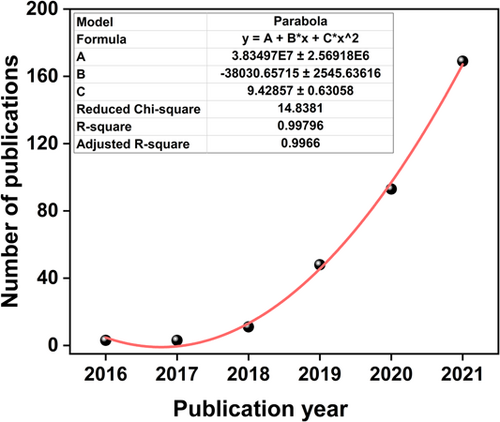
Subsequently, the distribution of research areas was scrutinized. According to Figure 2, Materials science, Science & technology, other topics, Chemistry, Physics, Pharmacology & pharmacy, Engineering, Biochemistry & molecular biology, Research & experimental medicine, Oncology, and Biotechnology & applied microbiology were top-10 major research areas. Overall, it was shown that the documents were of multidisciplinary nature, and might provoke interests from multiple fields. Therein, Materials science, Science & technology, other topics, Chemistry, Physics, and Engineering were mainly associated with the “nanoscience” aspect, while Pharmacology & pharmacy, Biochemistry & molecular biology, Research & experimental medicine, Oncology and Biotechnology & applied microbiology were mainly linked to the “ferroptosis” aspect. As Materials science ranked as the top-1 research area (151 documents, or 46.18%), we speculated that a considerable proportion of documents conveying the synthesis, characterization, and application of nanosystems for ferroptosis induction or inhibition [28].
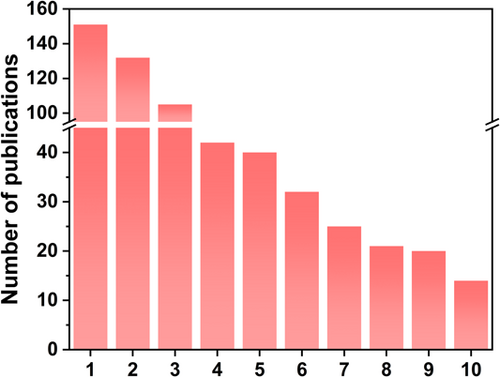
To explore the major publication media for the documents, the top-10 publication titles were illustrated in Figure 3 with the impact factor (released in 2021) thereof. The top-10 list included ACS Applied Materials & Interfaces (15, 4.88%), ACS Nano (14, 4.28%), Biomaterials (13, 3.98%), Journal of Materials Chemistry B (12, 3.67%), Biomaterials Science (10, 3.06%), Theranostics (10, 3.06%), Small (9, 2.75%), Angewandte Chemie International Edition (8, 2.45%), Nature Communications (8, 2.45%), Advanced Healthcare Materials (7, 2.14%), Journal of Nanobiotechnology (7, 2.14%), and Nanoscale (7, 2.14%). All journals were important ones in the field of material and chemical science with relatively high impact factors (6.331–15.881) [29], indicating that these categories of journals were the major publication platforms for the relevant studies.
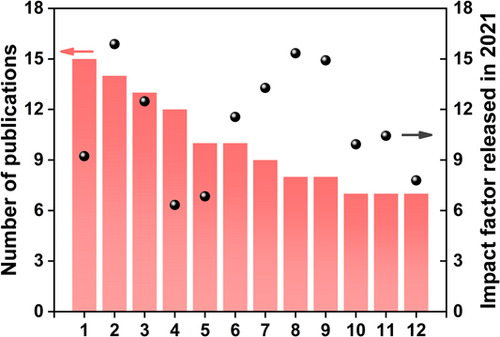
The distribution of countries/regions was analyzed, and those contributing over five documents of interest are listed in Figure 4. China made the greatest contribution (258, 78.90%), remarkably beyond the other countries/regions. The topic might have exerted particular interest for Chinese investigators. United States (40, 12.23%) and Australia (11, 3.36%) took the second and third place, respectively. Japan, Singapore, Spain, Germany, and South Korea contributed 6–10 documents, accounting for 1.83%–3.06%. Countries/regions in many continents like Asia, Europe, North America, and Oceania participated in the relevant studies, demonstrating the global research interest.
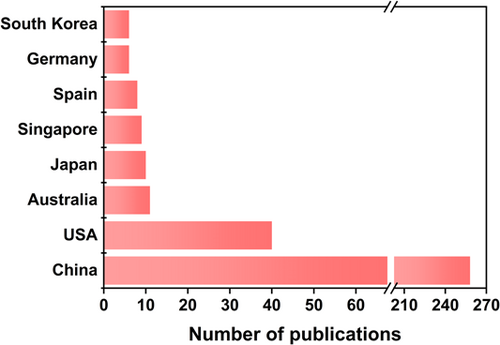
Further, the annual country/region-sorted number of publications is shown in Figure 5. Surprisingly, China with most contributing documents did not initialize the study. In 2016, United States, Australia, Japan, and Germany took the lead to the exploration by the first three papers, and China participated in the second year (2017). But from then on, China started making greatest contribution each year. United States also made a considerable contribution every year. The contribution of other top countries/regions was basically comparable. By virtue of Figure 5, the detailed growing trend of countries/regions was visualized.
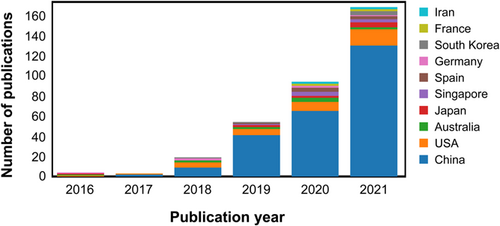
The distribution of organizations is summarized in Table 1. In accordance with the result that China contributed most papers, the top-10 organizations were all affiliated to this country. Except for the top-1 organization (Chinese Academy of Sciences), the else were all universities. Chinese Academy of Sciences, Shanghai Jiao Tong University, and Zhejiang University contributed 39, 25, and 20 papers, respectively, ranking as top 3. The other organizations contributed less than 20 papers. These organizations were fruitful in the front of nanoscience-ferroptosis.
| Organization | Number of publications | Proportion (%) |
|---|---|---|
| Chinese Academy of Sciences | 39 | 11.93 |
| Shanghai Jiao Tong University | 25 | 7.65 |
| Zhejiang University | 20 | 6.12 |
| Sun Yat-sen University | 14 | 4.28 |
| Southeast University, China | 13 | 3.98 |
| China Pharmaceutical University | 12 | 3.67 |
| Shandong University | 12 | 3.67 |
| University of Chinese Academy of Sciences | 11 | 3.36 |
| Fudan University | 10 | 3.06 |
| Chongqing University | 9 | 2.75 |
| Tongji University | 9 | 2.75 |
Finally, the distribution of funding agencies was explored (Table 2). Of the top-10 funding agencies, 8 located in China (National Natural Science Foundation of China, National Key R&D Program of China, Fundamental Research Funds for the Central Universities, China Postdoctoral Science Foundation, Natural Science Foundation of Zhejiang Province, Natural Science Foundation of Shandong Province, Natural Science Foundation of Jiangsu Province, and Natural Science Foundation of Guangdong Province) and 2 in United States (National Institutes of Health and United States Department of Health Human Services). It was advisable for new investigators to seek financial supports from these funding agencies. These results partly explained the reason why China and United States were the major contributing countries/regions. Besides, National Natural Science Foundation of China funded for a majority of research (over two-thirds), which was markedly beyond other funding agencies (lower than one-sixth). We believed that this funding agency emphasized the exploitation of combination of nanoscience and ferroptosis.
| Funding agency | Country/region of funding agency | Number of publications | Proportion (%) |
|---|---|---|---|
| National Natural Science Foundation of China | China | 220 | 67.28 |
| National Institutes of Health | United States | 52 | 15.90 |
| National Key R&D Program of China | China | 36 | 11.01 |
| Fundamental Research Funds for the Central Universities | China | 25 | 7.65 |
| China Postdoctoral Science Foundation | China | 19 | 5.81 |
| United States Department of Health Human Services | United States | 19 | 5.81 |
| Natural Science Foundation of Zhejiang Province | China | 14 | 4.28 |
| Natural Science Foundation of Shandong Province | China | 13 | 3.98 |
| Natural Science Foundation of Jiangsu Province | China | 12 | 3.67 |
| National Natural Science Foundation of Guangdong Province | China | 9 | 2.75 |
By far, the general bibliometric profile of nanoscience-ferroptosis research was described, in terms of demographics, publication years, research areas, publication titles, countries/regions, organizations, and funding agencies. The understanding of general bibliometric profile facilitated the further bibliometric analysis.
2.2 Coauthorship visualization
Coauthorship of nanoscience-ferroptosis papers was scrutinized, so as to interpret the paradigm of authorship and collaboration in this field.
The cooperative relationship among countries/regions was depicted in Figure 6. In the pattern of chord diagram, the cooperation tiles were presented as connecting curves, and the thickness of connecting curves was proportional to the number of collaborated papers [30]. On the whole, international collaboration was active, and multiple cooperation tiles were constructed. Intercontinental (e.g., Japan–Australia) and intracontinental (e.g., Poland–Denmark) cooperation was observed. As the top-1 contributor, China established cooperation tiles with 12 countries/regions, that is, Germany, Israel, United States, France, Japan, Australia, Singapore, South Korea, Brazil, Denmark, Nepal, and Pakistan. Other top-10 contributors like United States, Australia, and Japan also built a couple of cooperation tiles. Only a few countries/regions not yet constructed cooperation tiles, namely Romania, Ethiopia, and Saudi Arabia. The active international collaboration could favor the collision of ideas and boost the breakthrough in this field [31].
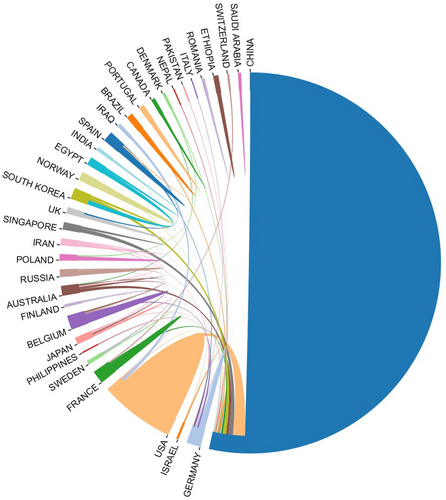
The coauthorship relationship among organizations was studied. With the help of VOSviewer, coauthorship of organization was mapped. Herein, item size represented the number of publications, item color suggested its mean publication time that ranged from approximately June 2019–January 2021. It was worth mentioning that the mean publication time of all documents were quite recent, reflexing that this was an active research area. The connecting lines expressed the cooperation tiles, whose thickness was proportional to the number of collaborated documents [32]. The results are shown in Figure 7. There were six clusters in the entire set (Figure 7a): One complex cluster centered by Chinese Academy of Sciences, and five isolated clusters, that is, Central South University, Tianjin University, Nagoya University, Sichuan University, and Northwestern Polytechnical University. Nagoya University (Japan) was the only one organization not affiliated to China. No cooperation tile was established among the six clusters.
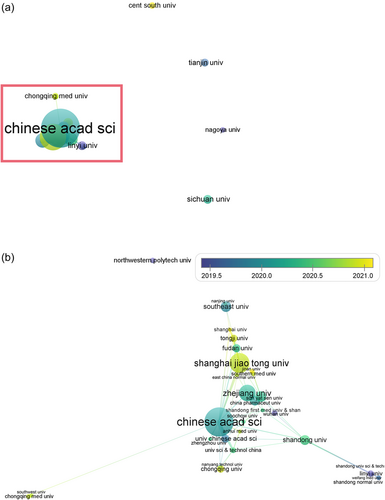
The magnification of the complex cluster in the red box is shown in Figure 7b. Almost all organizations were in China except Nanyang Technological University (Singapore). No isolated organization was found. The top-3 organizations in Table 1, Chinese Academy of Sciences (15 links), Shanghai Jiao Tong University (9 links), and Zhejiang University (4 links), acted as centers in the map, suggesting that they actively participate in collaboration. Also, Shandong University (8 links), University of Chinese Academy of Sciences (7 links), Sun Yat-sen University (7 links), and Tongji University (7 links) were active collaborators. It was recommended to build cooperation tiles with these organizations for newly emerging investigators.
From the above results, China evidently paid much attention to the acedemic cooperation in this field, internationally and intranationally. However, comparing Figure 6 with Figure 7, international cooperation tiles seemed to be active, while actually very little coauthorship existed between organizations from different countries/regions. It cound be deduced that the degree of global cooperation was even less than the cooperation of organizations within China. This was an issue pending the mutual effort of worldwide researchers, and more international cooperations were appealed. Investigators outside China were suggested to connect more with those in China, vice versa [33].
Setting authors as the unit, the coauthorship profile was explored. Similar to the results of organization coauthorship, all authors exhibted quite recent mean publication time, indicating that they might still be active contributors. We could follow these fruitful authors for their upcoming studies upon nanoscience-ferroptosis. The authors were clustered into nine groups (Figure 8): (1) Fei, Weidong (Zhejiang University); Li, Chaoqun (Zhejiang University and Zhejiang Chinese Medical University). (2) Liu, Fang (Tianjin University); Zhao, Yanjun (Tianjin University); Wang, Zheng (Tianjin University); Fan, Aiping (Tianjin University). (3) Chen, Yu (Shanghai University and Chinese Academy of Sciences). (4) Wang, Hui (Anhui Medical University); Zhang, Li (Anhui Medical University). (5) Shen, Qi (Shanghai Jiao Tong University); Zhang, Jun (Shanghai Jiao Tong University). (6) Toyokuni, Shinya (Nagoya Univeristy and The University of Sydney). (7) Dai, Zhichao (Linyi University); Zhang, Dongsheng (Linyi University and Shandong Normal University); Yao, Xiuxiu (Linyi University and Shandong University of Science and Technology); Zheng, Xiuwen (Linyi University). (8) Luo, Zhong (Chongqing University); Li, Menghuan (Chongqing University and Nanyang Technological University). (9) Chen, Xiaoyuan (National Institutes of Health and National University of Singapore). Cooperation was carried out within each group, but not among groups. Interestingly, no pronounce centers were formed in each group, demonstrating that the authors made comparable contributions. It was shown that most coauthorship behaviors took place among scientists in China, especially from the organizations with most contribution. These results were in parrelel with the above ones.
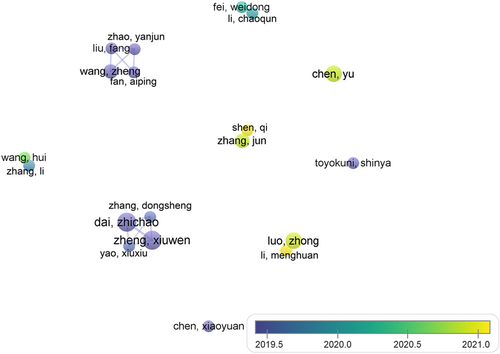
Thereby, the coauthorship had been analyzed on three levels, that is, countries/regions, organizations, and authors. Taken together, coauthorship was a common phenomenon in this field, and academic collaboration in China was highly active.
2.3 Cocitation and bibliographic coupling analysis
Cocitation and bibliographic coupling were two vital concepts in bibliometric studies. The definitions of them were as follows [34]. Cocitation: Two references were cited by one document in the current set; Bibliographic coupling: Two documents in the current set cited one reference. They were employed to mine the inner connections between documents, which would provide valuable bibliographic information [35]. Bibliographic coupling and cocitation were then analyzed.
The result of cocitation analysis is visualized in Figure 9. The documents were classified into two clusters, colored by red and green, respectively. The number of times cited was represented by the item size, and that of times cocited by the thickness of connecting lines [36]. Roughly, the red and green cluster assembled the documents about the fundamental mechanisms of ferroptosis (e.g., Dixon SJ 2012, Cell; Hangauer MJ 2017, Nature; Jiang L 2015, Nature) and the ferroptotic nanomedicines for cancer therapy (e.g., Shen ZY 2018, ACS Nano; Liang C 2019, Advanced Materials; Zheng DW 2017; Nano Letter), respectively. This was to some degree in consistency with the distribution of research areas (Figure 2).
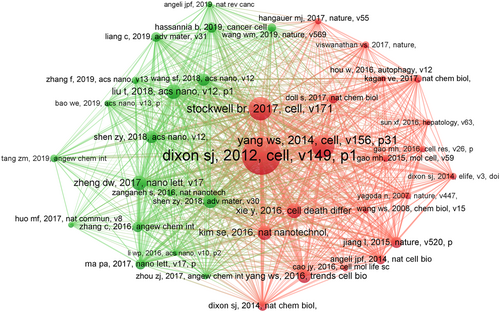
A highly dense network demonstrated the prevailing cocitation behavior, and the displayed documents were regarded as important basis for this field [37]. For instance, three documents with large item size distributed as the “Iron-Triangle” in Figure 9: Dixon SJ 2012, Cell; Stockwell BR 2017, Cell; Yang WS, 2014, Cell. The “Iron-Triangle” documents all belonged to red cluster, which mainly reported the molecular mechanisms. (1) Dixon SJ 2012, Cell: An article firstly proposed the concept of ferroptosis and identified the inducer and inhibitor [15]. (2) Stockwell BR 2017, Cell: A primer introduced the accumulated evidence of the molecular mechanisms of ferroptosis and the connections with diseases [38]. (3) Yang WS, 2014, Cell: An article reported GPX4 as a down-regulator for cancer cell ferroptosis, which could serve as an anticancer target [39]. Evidently, studies on ferroptosis-regulating nanomedicines, particularly those for antitumor treatment, were apt to cite these papers. It was believed that these documents would continue to serve as the foundation for future studies, and motivate new paradigm of research. Moreover, the three documents were all published in the Cell journal. As a flagship journal about the fundamental research on the cellular and molecular level, Cell preferred to publish such research [40]. From this perspective, nanoscientists were encouraged to follow the state-of-the-art papers in the journal like Cell, to be informed of the discovery of new signal pathways and drug targets.
The visualization of bibliographic coupling is provided in Figure 10. The coupling network was dense, elucidating the heavy coupling profile. It was reported that the coupled documented possessed a high similarity in research paradigm (not similarity in content that meant plagiarism), because the shared citations indicated a similar background [41]. Thus, the 34 documents shown in Figure 10 probably exhibit the greatest similarity in research paradigm out of the entire 327 documents. From a certain point of view, these documents were most representative ones of nanoscience-ferroptosis studies; we could grasp the typical research diagram of this field by referring to them.
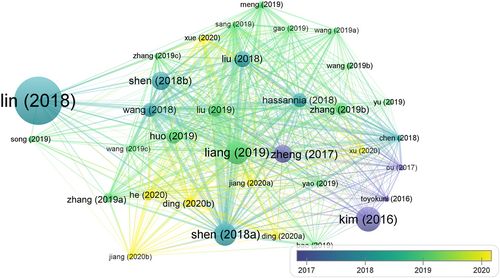
In this context, four representing documents were taken as examples and discussed: Lin (2018); Kim (2016); Liang (2019); Shen (2018a). They were selected due to the item size and different types: Lin (2018)—communication, Kim (2016)—article, Liang (2019)—progress report, Shen (2018a)—review. (1) Lin (2018) synthesiszed MnO2-coated mesoporous silica nanoparticles (MS@MnO2 NPs) as an activatable theranostic platform with improved chemodynamic effect for cancer therapy [42]. (2) Kim (2016) established alpha-melanocyte stimulating hormone functionalized poly(ethylene glycol)-coated new generation Cornell dots (αMSH-PEG-C'-dot) that suppressed the growth of amino acid-deprived cancer cells [43]. (3) Liang (2019) reported the progress on small molecules and nanomaterials as ferroptosis inducers to treat carcinoma, and put forward some considerations and challenges [44]. (4) Shen (2018a) reviewed the current strategies of ferroptosis-based cancer treatment, and the strengths and limitations thereof [45]. It was shown that both research-form and review-form papers discussed mainly the development and applicaton of ferroptosis-targeting nanomedicines, especially for cancer therapy, generating the common publication paradigm.
Additionally, all 34 documents were published in 2016–2020, whereas no one in 2021. This result could be explained by that the 2021 documents shared less similarities with the previous ones, possibly elaborating that new research paradigm was emerging. We might anticipate innovative ideas through dissecting papers published in 2021 or later.
The analysis of cocitation and bibliographic coupling clearly outlined the research diagram of this field. Nevertheless, it should be noted that the principle of cocitation and bibliographic coupling was on top of the citation behavior, which might show a certain extent of hysteresis [46]. The evolutionary aspect of the research diagram must be concerned as well.
2.4 Mining and mapping of high-frequency terms
To claim the research paradigm of nanoscience-ferroptosis studies on an evolutionary dimension, the high-frequency terms were mined and mapped. Herein, “terms” included keywords attached in the abstracts and terminologies used in the full text, both of which could mirror the emerging hotspots in the frontier [47].
The high-frequency keywords were extracted, and the co-occurrence profile was depicted in Figure 11. The extracted keywords could be categorized into six groups. (1) Searching themes: Nanoparticles, ferroptosis, and nanoplatform. (2) Nanomaterials: Iron-oxide nanoparticles, gold nanoparticles, and oxide nanoparticles. (3) Ferroptosis mechanisms: Iron, cell-death, death, glutathione, oxidative stress, lipid-peroxidation, Fenton reaction, and hydrogen-peroxide. (4) Biology general terms: Expression, activation, pathway, cells, inhibition, generation, biology, in vitro, metabolism, form, growth, mechanisms, toxicity, and in vivo. (5) Cancer therapies: Tumor, resistance, cancer, therapy, chemotherapy, apoptosis, photodynamic therapy, and cancer-cells. (6) Pharmaceutical development: Release, design, drug-delivery, and delivery. It should be acknowledged that some intersections between these six groups might take place. For example, “apoptosis” in group (5) was to some extent related with group (3), ferroptosis mechanisms. It was reported that apoptosis was probably activated during autophagy-dependent ferroptosis processes [48].
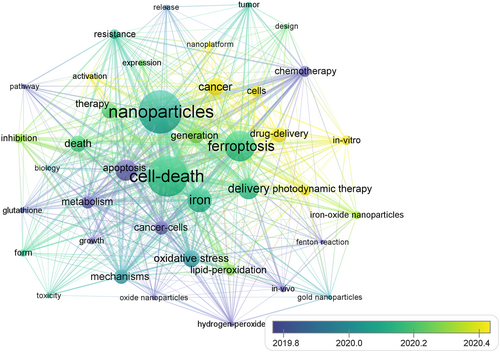
The high frequency of group (1) was as expected, since searching themes were very probable to present in the retrieved documents. Group (2) and (3) were actually derived from searching themes, the former revealed the commonly used nanomaterials, and the later indicated that the mechanisms were emphasized in the documents. The biology general terms in group (4) reflected that most documents were associated with biological experiments and theories. Suggested by group (5), the indication for cancer therapies was a hot topic. A part of papers discussed the pharmaceutical development aspect, according to group (6). Hence, the in vitro and in vivo evaluation of nanosystems based on ferroptosis regulation intended for cancer treatment was a focus of current studies.
As high-frequency keywords could reflect the research hotspots, analyzing the co-occurrence of keyword pairs in Figure 11 would help to understand the connections between hotspots [49]. The keyword pair with highest co-occurrence rate was nanoparticles-cell death (link strength = 30), which claimed the ultimate aim of the related studies was to discover nanosystems to manipulate the cell death process. There were other keyword pairs showing high co-occurrence rates, including cell death-iron (link strength = 25), nanoparticles-ferroptosis (link strength = 19), nanoparticles-iron (link strength = 18), and nanoparticles-delivery (link strength = 17). It was conjectured that iron-based nanoparticles or nanoparticles encapsulating ferroptosis inducers were a major research focus. Keyword pairs like nanoparticles-chemotherapy (link strength = 12) and ferroptosis-apoptosis (link strength = 12) indicated a growing trend, namely the cooperation of ferroptosis with other cell death pathways to enhance the therapeutic efficacy for diseases. Keyword pairs with low link strength represented emerging topics in the field. For example, the emerging topic of ferroptosis induced by noniron nanoparticles was manifested by gold nanoparticles-ferroptosis (link strength = 1).
Seen from the time axis in Figure 11, the average publication time of all high-frequency keywords was after 2019, demonstrating that they were most recent ones. From this perspective, they might represent the current hotspot in this field, or the popular research paradigm of nanoscience-ferroptosis.
Then, the co-occurrence of terminologies was visualized in Figure 12. The results were basically similar to the scenario of keywords, but the average publication time was even more recent (after 2020). Having been included in Figure 11, a large number of terminologies showed again in Figure 12: Ferroptosis, nanoparticle, therapy, cell, cell death, tumor, cancer, cancer cell, iron, mechanism, chemotherapy, apoptosis, glutathione, Fenton reaction, (in) vivo, (in) vitro, oxidative stress, and lipid peroxidation. Several terminologies were the primary or secondary derivatives or extensions of the aforementioned keywords, for example, glutathione peroxidase (reasonable extension of glutathione) and GPX4 (the abbreviation for glutathione peroxidase-4). Other derivatives or extensions included tumor cell (derivative of cancer cell), GSH (the abbreviation for glutathione), PDT (the abbreviation for photodynamic therapy), cancer therapy (reasonable extension of therapy), treatment (derivative of therapy), cancer treatment (derivative of cancer therapy), nanomaterial (derivative of nanoparticle), and development (reasonable extension of design). It was worth mentioning that there were important new terminologies, namely tumor microenvironment (the combination of tumor cells, immune cells, extracellular matrices, cytokines, etc., which could affect the activation or inhibition of ferroptosis), reactive oxygen oxidase and ROS (the abbreviation for reactive oxygen oxidase). The terminologies strategy, application, effect, study, review, and work were assigned to general terms that widely used in scientific papers. In summary, research hotspots revealed by terminology mining were similar to that by keyword mining.
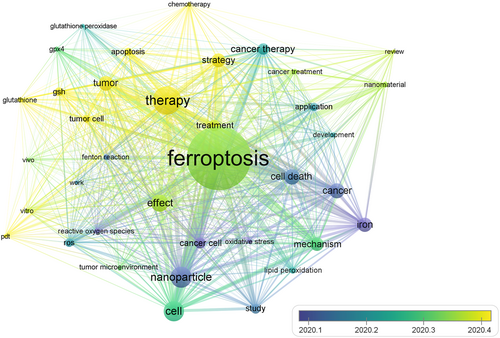
The co-occurrence status of terminologies was also similar with that of keywords. To be specific, nanoparticle-cell death (198), nanoparticle-ferroptosis (709), cell death-iron (105), and nanoparticle-iron (178) exhibited high level of link strengths. Ferroptosis-PDT (link strength = 146), ferroptosis-chemotherapy (130), and so forth demonstrated the emphasis on ferroptosis-based combined therapy. A significant finding was that ferroptosis-tumor microenvironment possessed a high link strength of 141, which suggested that the interplay of both counterpart was comprehensively investigated.
The mining and mapping of keywords and terminologies and their co-occurrence revealed that the major research diagram of the nanoscience-ferroptosis field was the design and development of ferroptosis-inducing nanosystems for oncolytic purpose, and the combination of ferroptosis with other cell-death pathways was a growing tendency. These results were typically in accordance with the distribution of research areas and the trend reflexed by cocitation and bibliographic coupling.
2.5 Inspiration for future exploration
- (a)
Discovering ferroptosis inducers or inhibitors from traditional medicine and designing tailored nanosystems for them. With its rich historical records and high availability, the traditional medicines derived from herbals, animals, or ores were considered as valuable resources for active pharmaceutical ingredients. Recently, a variety of molecules associated with traditional medicine were reported to be capable of regulating ferroptosis, which could also be integrated into nanosystems for disease therapy. Several herbal derived molecules, including artemisinin derivatives [50] and isothiocyanates [51], had been developed as ferroptosis inducers for tumor elimination. Besides, the ferroptosis inhibition effect of baicalein [52] and puerarin [53] were validated to anti-inflammatory or antiosteoporosis therapy. To improve the delivery performance and maximize the therapeutic effect, the tailored nanosystems loaded with traditional medicines should be urgently proposed. The combination of traditional medicine and modern nanoscience was expected to shed light on the proper applications of herbal ferroptosis regulators. According to the bibliometric analysis, China was the major contributor in nanoscience-ferroptosis studies, and thus the involvement of traditional Chinese medicine was expectable.
- (b)
Developing ferroptosis-regulating nanomedicines for the therapy of diseases other than cancer. As a ubiquitous physiological mechanism, the ferroptosis process was involved in diverse diseases, not only tumor but also inflammatory [54], neurodegenerative [55], and cardiovascular diseases [56]. The critical role of ferroptosis in many diseases were gradually revealed. Thus, regulating ferroptosis-related signals by nanomedicines had great potential for proposing new therapeutic strategies for nontumor diseases. On one hand, with desired nanotechnology, the ferroptosis pathway could be employed as a brand-new regulating target for the therapy of currently incurable diseases, which provided potential remedies for patients. On the other hand, first-line drugs in clinic accompanied with newly developed ferroptosis regulator was rising as a promising approach to improve therapeutic effect and avoiding side effects of current treatments [57]. By encapsulating multiple drugs in a sophisticated nanomedicine, the on-demand ferroptosis assisted therapy strategy was burgeoning. In summary, the studies of ferroptosis regulating nanomedicines on combating nontumor diseases were worthy of concern.
- (c)
Employing nanoscience and nanotechnology to further study the underlying mechanisms of ferroptosis. Nanotechnology was proved as a powerful tool to investigate the ferroptosis mechanism. The PUFAs containing liposomes had been constructed to mimic the lipid peroxide process under physiological or pathological conditions, which could promote the understanding of ferroptosis-mediated cell damage mechanism [58]. Besides, the nanoscale exosomes had also been involved in ferroptosis study. The exosomes derived from bacterial [59] or virus-infected cells [60] were validated to participate in the intercellular ferroptosis signal conductions during infection, and the patient-extracted exosomes were comprehensively analyzed to evaluate the biomarkers of ferroptosis-related diseases [61]. For the future, except for the applications of liposomes and exosomes, the smart nanosensors or nanodetectors were another hopeful field to sensitively detect the subtle intracellular biomolecule changes in ferroptotic cells or tissues, which was expected to be helpful in ferroptosis mechanism exploration.
By far, as proof-of-concept research, the publication paradigm of nano-ferroptosis studies was successfully scrutinized. We expected that this piece of work could add understandings toward explication of publication paradigm. Moreover, the method can also be used for reviewing the advancement of a new therapy or technology, assisting in healthcare policy-making and decision-making.
It should be noted that there was some limitation of current study: Link strength (edge) was the main quantitative indicator utilized to analyze the co-occurrence networks. In future studies, other quantitative indicators such as betweenness centrality and shortest path can be employed to conduct a more comprehensive evaluation [62, 63].
3 CONCLUSION
In this paper, an approach to explicate publication paradigm was proposed. As a proof of concept, bibliometric analysis was performed to provide a full picture of the interplay between ferroptosis and nanoscience. The general bibliometric profile of 327 documents of interest indicated the emerging global attentions for such a topic with rapid increment, which were distributed in multiple fields like Materials science, Science & technology, Chemistry, Physics, and Pharmacology & pharmacy. The researchers and institutions form China contributed most of the publications, and followed by United States and Australia. The Chinese researchers widely cooperated with other researchers nationally and internationally to promote the idea collision. Cocitation and bibliographic coupling analysis showed the connection and similarity between documents. The original papers about molecule mechanisms of ferroptosis were cited as foundation for ferroptosis-nanoscience studies, and the model of papers reporting ferroptosis-targeting nanomedicines for cancer therapy were considered as common publication paradigm. The analysis of keywords and terminologies confirmed that the mechanism evaluation of ferroptosis regulation therapy for cancer treatment was the main hotspot. Based on the analysis, the ferroptosis-nanoscience involvements in traditional medicines, nontumor diseases and underlying mechanisms were proposed as possible future explorations directions. In general, this paper offered an overview of the research on the interplay between ferroptosis and nanoscience, and provided new ideas for the follow-up investigation in concerned fields, especially for how to unveil the publication paradigm.
4 METHODS
For clarity, a workflow of this study is displayed in Figure 13. For other fields, this workflow could be adopted as well after proper modification (mainly by changing the searching themes).
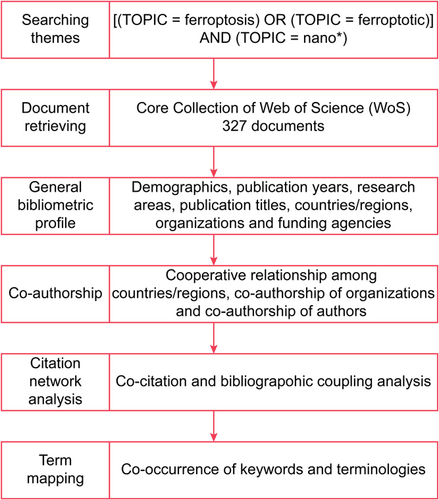
4.1 Documents retrieving
Concerned documents were retrieved from Core Collection of WoS, accessing through Jinan University Library at 3 p.m., February 17th, 2022 (UST+8). The searching theme was as follows: [(TOPIC = ferroptosis) OR (TOPIC = ferroptotic)] AND (TOPIC = nano*). Herein, “(TOPIC = nano*)” was used because it could include related documents as more as possible. The document type was limited to article and review. Considering that ferroptosis was firstly defined in 2012 [15], the searching timespan was initially set as January 1st, 2012–December 31st, 2021. A preliminary search returned that no related papers were published before 2017, and the final searching timespan was adjusted to January 1st, 2016–December 31st, 2021. Subsequently, full records and cited references of the documents retrieved were exported as text files (plain text and tab-delimited).
4.2 Bibliometric analysis
Under a Microsoft Windows 11 operating system installed with Visual C++ 2017 and Java 8 packages, bibliometric analysis was performed. The general bibliometric profile of documents of interest was analyzed. In detail, data about publication years, authors, publication titles, funding agencies, research areas, and countries/regions were obtained by the “Analyze Results” function of WoS [64]. The number of citing papers, times cited and H-index were extracted by “Citation Report” function of WoS [65]. The exported tab-delimited file was imported into the Bibliometric Online Analysis Platform (bibliometric.com), and the information of annual country/region-sorted number of publications and cooperative relationship amongst countries/regions was mastered [66]. The exported plain text file was imported into the VOSviewer software, and mapping of coauthorship, bibliographic coupling, cocitation, keyword co-occurrence, and terminology co-occurrence was conducted [67]. To acquire readable maps, for coauthorship, the minimum number of documents of an author/organization was 5; for bibliographic coupling, the minimum number of citations of a document was 50; for cocitation, the minimum number of citations of a cited reference was 30; for keyword co-occurrence, the minimum number of occurrences of a keyword was 10; for term co-occurrence, the minimum number of occurrences of a terminology was 40. Full counting method was used, and network maps and time-overlay maps were obtained [68].
AUTHOR CONTRIBUTIONS
Zhengwei Huang: Conceptualization (lead); writing—original draft (lead). Wenhao Wang: Data curation (lead); formal analysis (lead); visualization (lead). Lei Shu: methodology (equal); visualization (equal). Mengqin Guo: Formal analysis (supporting). Ying Huang: Conceptualization (equal); funding acquisition (equal); resources (equal). Chuanbin Wu: Supervision (equal); writing—review & editing (equal). Xin Pan: Supervision (lead); writing—review & editing (equal).
ACKNOWLEDGMENT
The authors acknowledged the financial support from the National Natural Science Foundation of China, under grant nos. 82073774, 81973263, and 82104070.
CONFLICT OF INTEREST
The authors declare no conflict of interest.
ETHICS STATEMENT
The authors declare no ethics statement.
INFORMED CONSENT
None.
Open Research
DATA AVAILABILITY STATEMENT
There was no related data set. The original data associated with this manuscript could be obtained upon request to the authors.



